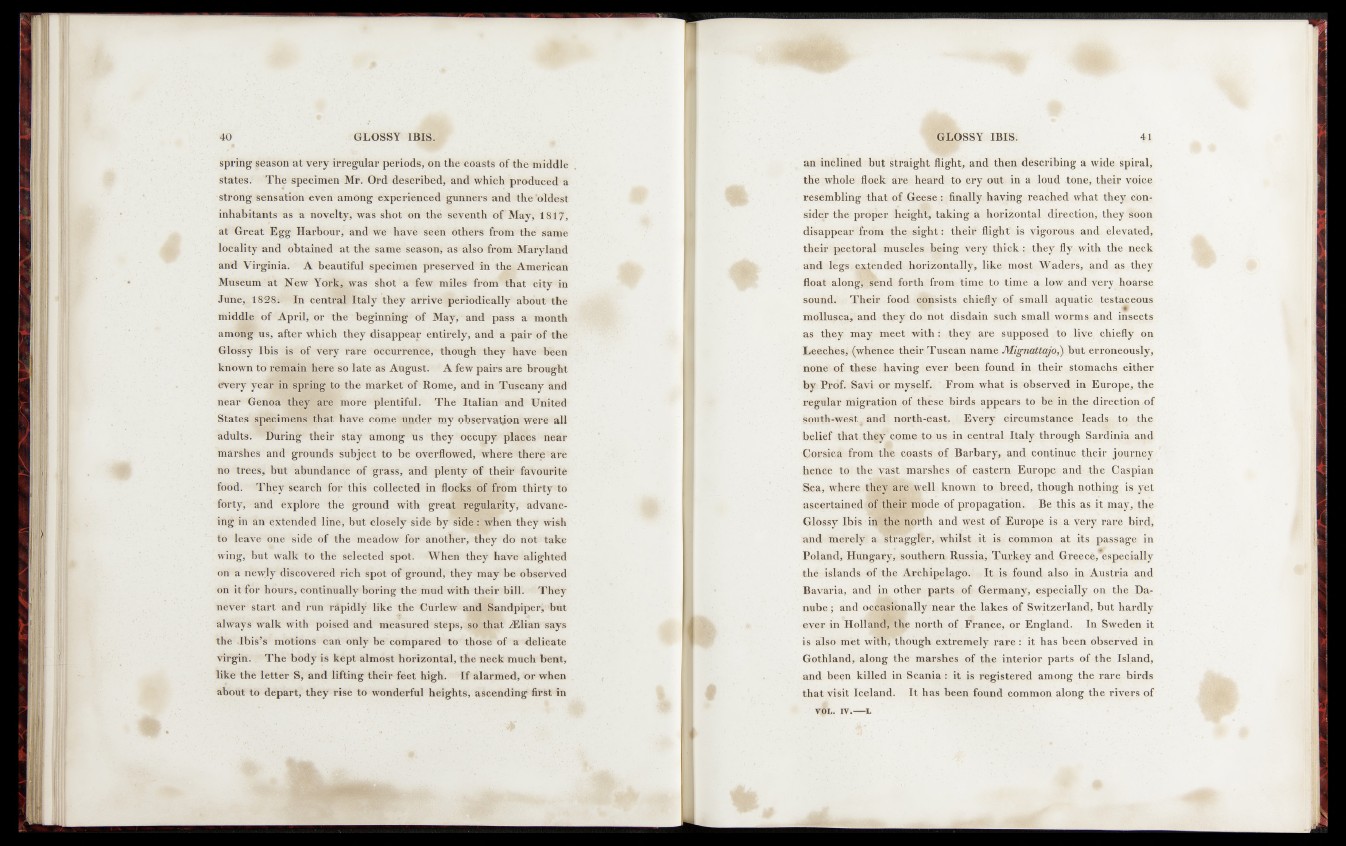
spring season at very irregular periods, on the coasts óf the middle
states? 'The specimen Mfc Ord described, and which produced- a
strong sensation even among experienced gunners and th e ’oldest
inhabitants as a novelty, was shot on the seventh of'Mayx 1817,
atT Great Egg Harbour, and we havé see-» ethers from the same
locality and obtained at the same season, as also from Maryland
and Virginia. A beautiful specimen preserved in th&Americam
Museum‘a t New York,, »was shdt'a'few miles fr0m*lhat city 'in
-MMSSMNI In centfnnEtàly they arrivefÿeriodically about-the
middle of April, èr the ' beginning of May, and pass a month
am Jpg us, after which they disappear entirely, and a pair of the
©lossy Ibis is of very rare occurrence, though they have hfeen
known to r^r^ain here so late as August. A few pairs are brought
éfvery yeâfiSn spring to the market of Rome, and in Tuscany and
near Geneir th ea tre* more plentiful. The Italian and ®4ittd
States speeiirienirtnat have come under my observation were all
adülts. ^xriirin^' their stay among Us they occupy pMefes near
îiêt^he» and grounds subject to be overflowed, wheré there -arè
no trees, but abundance of grass, and pleftty of their faVonritè
food. They- tesÉrcb for this eèllecffiid in fio&gjibf from thirty3!®
forty, and explore the ground with greatjæégLd'arity, advancing
in an extended lfoe> but closely side by siue|||phen they wish
to- leave Ond%i^ Of meadow for another, they do not take
wing, fwtt walk to the selected spot. When they have alighted
on a nervdy discovered rich spot of ground, they may be observed
on it for hours, Continually boring the.mud With their bill. - They
never start and run râpidly like the Curlew an<l,?;Sandpiper;- but
always walk with poised and meâsured steps, slf thift Ælian says
the .Ibis’s motions can only be compared to those*of' a delicate
virgin. The body is kèpt almost horizontal, the neck much bent,
like thé letter S, attd lifting their* feet high. If alarmed, or when
about to depart, they rise to wonderful heights, ascending first in
an inclined but straight flight, and then describing a wide spiral,
the whole flock are heard to cry out in affijjÿiÉ .tone, their voice,
resembling that of Geese : -finally having reaehed what they Consider
the proper heigral taking a horizontal direction, they Hoon
disappear from the sight : then?' flight' is vigorous and elevated,
theiftipeetoral muscles being yery tifeick.^they fly, with.the neck
and -legs, expended horizontally, like m.®Sf W aders, and as they
float alon^fpend forth from time. to time a lOA hoarse
sornUd. <1 Their food iljasists, chiefly <jf smalhÿpiatic testaceous
mollusca, and they do, not disdain such small wo^ms and insects
as they may meet with : they a#e supposed to .Jive, chiefly on
Jjeeches, (whence their Tuscan name Mignattaja,') but erroneously,
none of these , haying ever been found in their stomachs either
by Prof. Savi or myself. ' From what is observed in Europe, the
regular migration of thèse birds appears to be?in the direction,of
south-west .and’ north-east. Every circumstance lead& ,to!i.^!p
belief thattheÿ" corné to*us>: in central Italy tro u g h Sardinia and
•peswiejt from thfe coasts óf Barb ary., and continue their journey,
hence to the. vast marshes .of- eastern. Europe and-the Caspian
Sea, where tlmw,afe*well known to heeêdj .though nothing is yet
ascertained |of th,eir( uSode of propagation. Be this as it may, the
Glossy Ibis irifthe north and west of Europe is a very rare bird,
and merely a Wraggftr, whilst -it is common at its passage in
Poland, Hungary, southern Russia, Turkey and Greece, especially
the islands of the Archipelago. It is found also in Austria and
Bavaria, and in other p a rts. .of Germany, especially on thé Danube;
and oe^Rpnally near the lakes Of Switzerland, but hardly
ever in HollancPtle north of .France, or England, In Sweden it
is also mèt wu ff? Though. extremely rare : it has been Observed in
Gothland, along the marshes of jhe interior parts of the Island,
and been killed in Scania: it is registered among the rare birds
that visit Iceland. It has been found common along the rivers of-
■ VOL. IVi^HhV